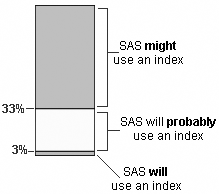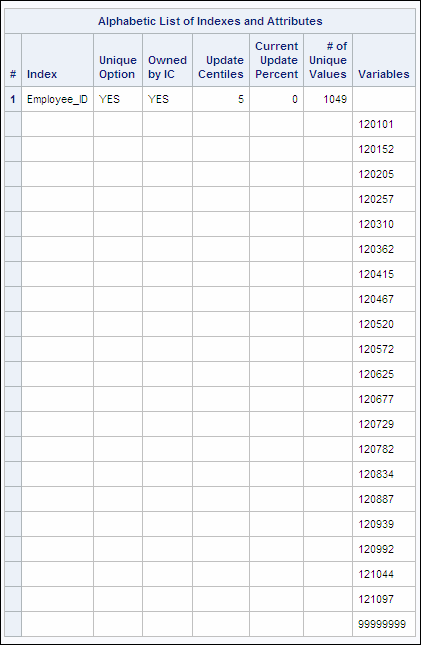Estimating the Number of Observations
Overview
It is more efficient to use indexed
access for a small subset and to use sequential access for a large
subset. Therefore, after identifying any available indexes and evaluating
the conditions in the WHERE expression, SAS estimates the number of
observations that will be qualified by the index. Whether SAS uses
an index depends on the percentage of observations that are qualified
(the size of the subset relative to the size of the data set), as
shown below:
-
If the subset is less than 3% of the data set, direct access is almost certainly more efficient than sequential access, and SAS will use an index. In this situation, SAS does not go on to compare probable resource usage.
-
If the subset is between 3% and 33% of the data set, direct access is likely to be more efficient than sequential access, and SAS probably uses an index.
-
If the subset is greater than 33% of the data set, it is less likely that direct access is more efficient than sequential access, and SAS might or might not use an index.
When multiple indexes
exist, SAS selects the one that produces the fewest qualified observations
(the smallest subset). SAS does this even when each index returns
a subset that is less than 3% of the data set.
Printing Centile Information
To help SAS estimate
the number of observations that would be selected by a WHERE expression,
each index stores 21 statistics called cumulative percentiles, or
centiles. Centiles provide information about the distribution of values
for the indexed variable.
Understanding the distribution
of values in a data set can help you improve the efficiency of WHERE
processing in your programs. You can print centile information for
an indexed data file by specifying the CENTILES option in either of
these places:
-
the CONTENTS procedure
-
the CONTENTS statement in the DATASETS procedure
Example
The following SAS program
prints centile information for the data set Company.Organization:
proc contents data=company.organization centiles;
run;Partial output from
this program is shown below. As indicated on the left, an index is
defined on the variable Employee_ID. The 21 centile values are listed
on the right.
The 21 centile values
consist of the following:
|
Position in List
|
Value Shown in Output
Above
|
Description
|
|---|---|---|
|
1 (first)
|
120101
|
the minimum value of
the indexed variable (0% of values are lower than this value)
|
|
2-20
|
120152 - 121097
|
each value is greater
than or equal to all other values in one of the 19 percentiles that
range from the bottom 5% to the bottom 95% of values, in increments
of 5%
|
|
21 (last)
|
99999999
|
the maximum value of
the indexed variable (100% of values are lower than or equal to this
value)
|
Note: For information about updating
and refreshing centiles for a data file, see the SAS documentation.
..................Content has been hidden....................
You can't read the all page of ebook, please click here login for view all page.


